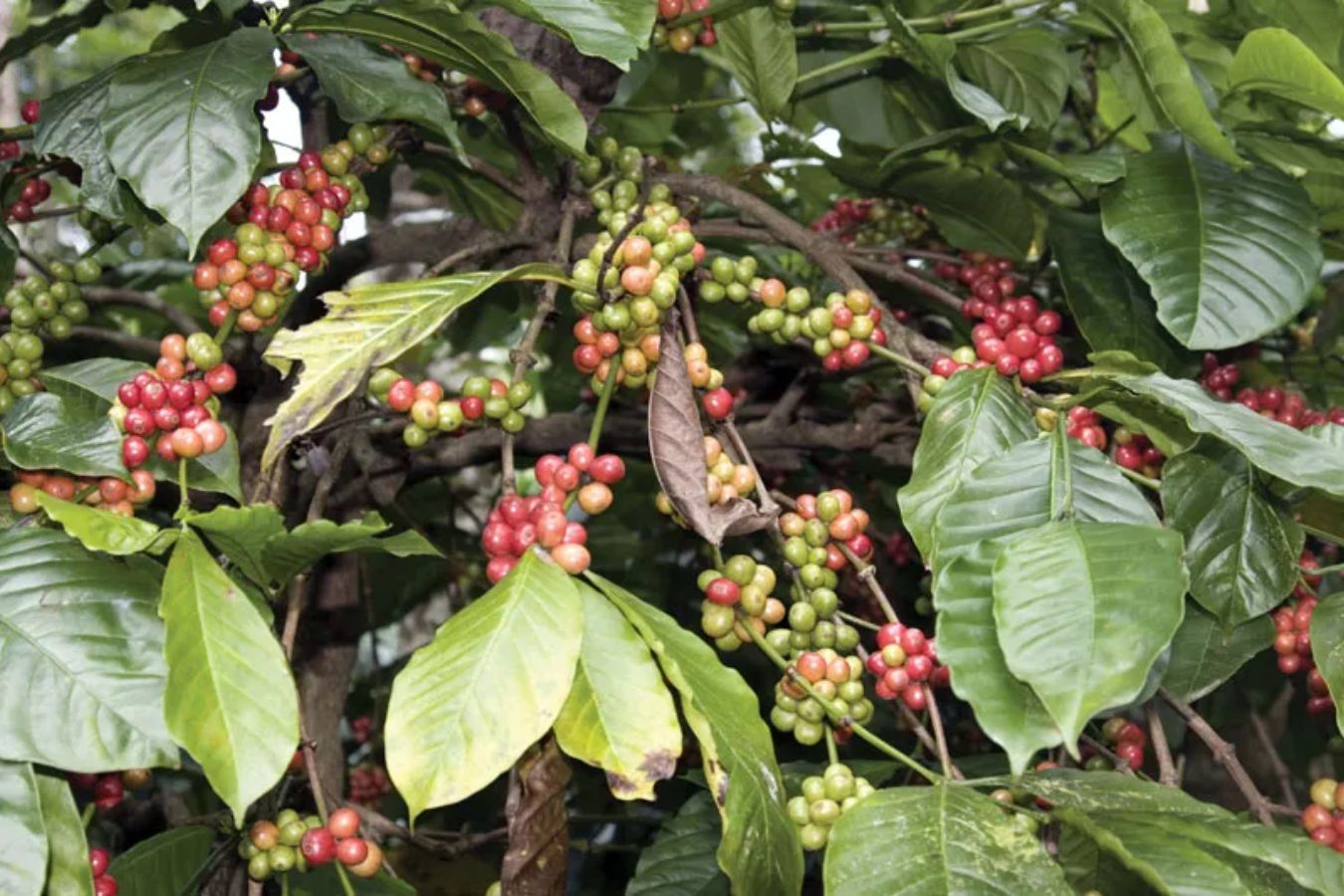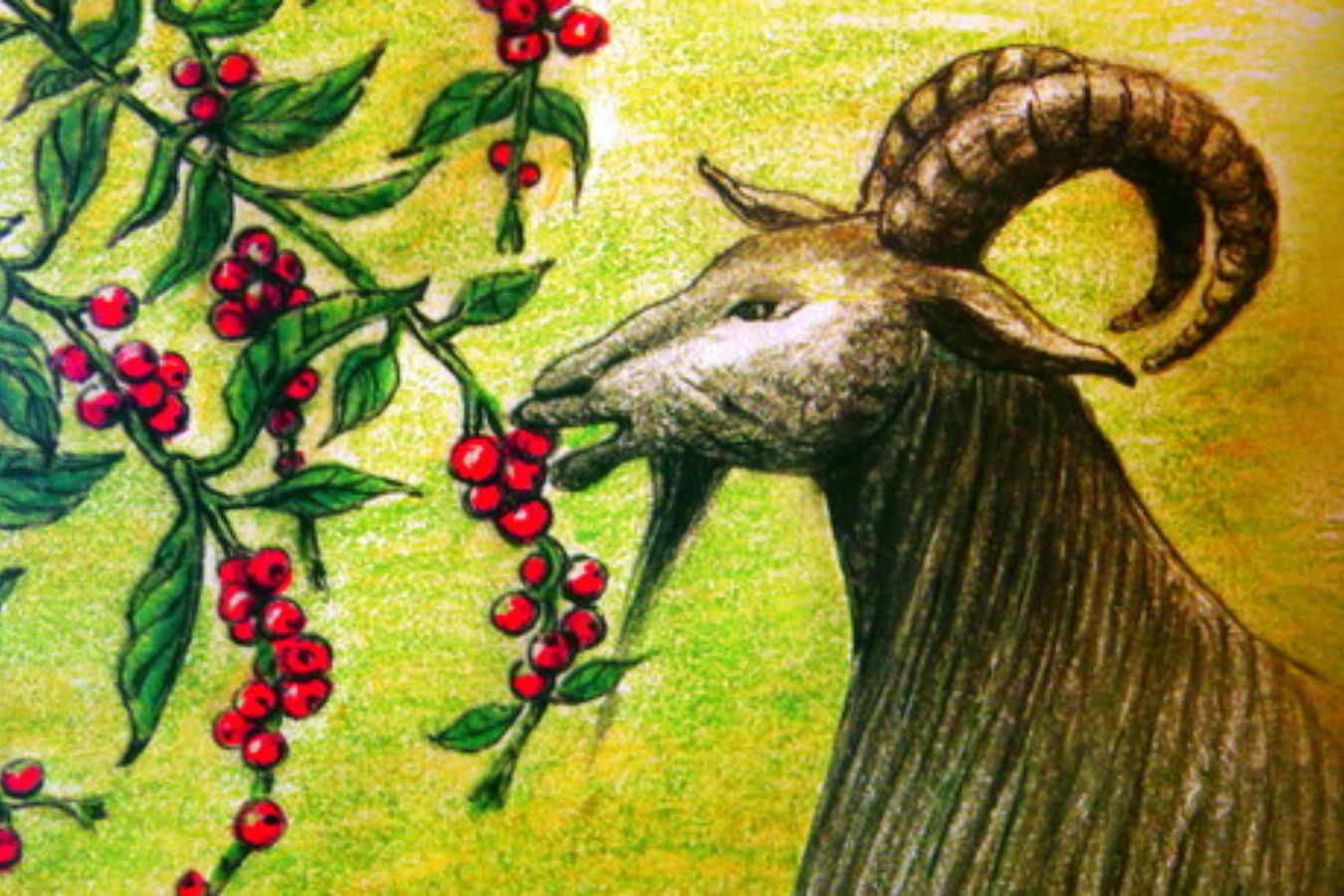
However, not everyone is aware of the origins of coffee and the significant events that have occurred throughout its history. The path from an unknown tree species to a mystical seed that amazes billions of people spans over 1000 years and is remarkable.
The History of the Coffee Tree: Goats Play a Role
No, this isn’t a joke; it’s 100% factual! It may seem hard to believe, but many records and evidence point to the same conclusion about this historical event.
It all began in Ethiopia, a country in East Africa, in the year 850 (AD). The protagonist of the story’s opening chapter, Kaldi, is a goat farmer. He became aware of something unusual in his goat herd one day.

The goats in the herd’s actions and reactions were out of the ordinary, and Kaldi couldn’t help but notice. Finally, he learned that the goats only did this when they ate a weird reddish-brown fruit that looked like a cherry (the coffee berry).
Kaldi felt compelled to eat the fruit himself due to his rising curiosity and temptation. He brought them to the village monastery to seek guidance from the wise monks after experiencing being full of life.
Kaldi felt compelled to eat the fruit himself as his curiosity and temptation grew. He brought them to the village monastery to seek guidance from the wise monks after experiencing being full of life.
The monk violently flung the fruit into the fire after inspecting and hearing from Kaldi. They were the epitome of heresy and evil, according to him.
The void in the sky, on the other hand, was significant. After encountering the fire and maturing, the coffee beans emanate an odd and captivating perfume. The entire monastery grew too interested in bearing, so they had to put out the fire and bring the findings back to “examine” from the beginning.
They tried soaking them in hot water, which fortunately resulted in a liquid coffee.
Who came up with the term “café”?
The French words “coffee” and “café” are not the original names for this bean. They’re all derived from the English term “coffee,” first used in 1582.
However, “coffee” isn’t the first word that comes to mind when thinking of coffee beans. In reality, the name coffee has been borrowed from a variety of languages around the world:
- The English word “coffee” is derived from the Dutch word “coffee.”
- The Dutch word “koffie” is derived from the Turkish word “kahve.”
- The Turkish word “kahve” is derived from the Arabic word “Yahweh.”
As a result, Arabic can be claimed to be the first language to name coffee beans. Arab countries are found in the Middle East, where this grain was first introduced after Ethiopia.
The Arabic word “qahwah” refers to an alcoholic beverage. It does, however, have a structure and meanings that are similar to other coffee-related words, such as:
In Arabic, “qua” means “source of energy, vitality.”
“Kaffa” was the name of an ancient Ethiopian monarchy that traded coffee with the Middle East.
Coffee origin myth: The First Cafe Development Milestone in the Middle East
When coffee was initially introduced to the world,
Let’s look at what’s going on in the Middle East, including Southwest Asia and Egypt, after the goat herd is linked to the Origin of coffee in Ethiopia.
According to history literature, the first evidence of coffee being imported from Ethiopia to Yemen dates from the end of the 15th century (a country in the Middle East located in the South Arabian Peninsula). Following that, further shipments of the exact nature arrived in the Yemeni port city of Mocha.

Coffee is commonly used by Sufis (a branch of Islam) in Yemen to improve concentration during praying, especially at night. They also regard drinking coffee to be a way to “purify the soul” after performing a religious ceremony.
Coffee beans were gradually introduced to numerous other places, including Mecca and Cairo (Egypt), Medina (Arabic), Damascus (Syria), Baghdad (Iraq), and Istanbul (Istanbul) (Turkey). People here are eager to respond, soon joining the international coffee addicts group.
Since then, the first cafes, known as “Schools of the Wise,” have been established, serving as a simple gathering space for people to converse.
The court of Mecca (Egypt) did not support coffee for whatever reason. They issued a proclamation prohibiting all city residents, but they finally withdrew for religious concerns.
Saint who breaks the law
In another episode, Baba Budan, a Sufi saint, smuggled seven raw coffee beans from Mocha city to India. This is a significant turning point in the globalization of coffee.
Why does Baba Budan have to do this in secret? Yemen sought to sell coffee exclusively during the time. As a result, they never sell raw beans to other countries to grow their seedlings; instead, they only offer roasted and pre-processed coffee beans.
Because “7” is a revered number in Islam and Sufism, the fact that Budan brought seven coffee beans to India has become even more widely known. Later, the farm that received that coffee adopted his name as the name of their business.
It was also the start of the narrative of coffee’s Origin in India, which spread fast throughout the country and nearby regions.
Cafe “Catch Trend” Campaign in Europe
Italy
In the year 1570, Venice (Italy) became the birthplace of coffee in Europe. Initially, coffee was misinterpreted as a mystical beverage, similar to how it was perceived in Ethiopia.
Coffee’s stimulating impact on the brain made them suspicious, and they had to consult the Pope the moment. In the end, Pope Clement VIII agreed since he had also tried drinking coffee and had become a “passionate fan.”
Netherlands
The Netherlands, like India, received the first coffee beans to grow as a result of… smuggling products across the border from Yemen.
However, because the weather in the Netherlands is too cold for coffee to adapt and grow, this is a bit of a pain to do. The most optimal solution to combat it was later devised: growing coffee in a greenhouse.
T-shirt
While Austria shares the environment of other European countries, it has its unique approach to introducing and developing coffee. The scenario, however, was a little “different” this time.
It all began on the battlefields of Vienna in 1683, when Austria, Germany, and Poland banded together to destroy the Ottoman Empire (former Turkey). After losing the battle, the enemy left behind the coffee warehouse, which has since been exploited and used to create a variety of tasty variations.
England
With the advent of coffee shops and the need to exchange and converse, the coffee culture in the United Kingdom is quite strong and developing.
These cafés are known as “Penny Universities” since you only need a penny (1 penny) to drink coffee and participate in intriguing and informative discussions.
Women also complained that coffee was like a second drink because their husbands seemed to enjoy frequent visits to the cafe. In 1674, they even started a protest against coffee to “rescue” the man of their lives.
Cafe Touches America’s Ground: Coverage Moves at the Speed of a Storm
Coffee’s ascension in the Americas
Coffee’s reputation continued to grow after the frenzy in Europe. Many European countries, however, still have coffee monopoly laws in place. As a result, importing this grain into the Americas in a typical manner is exceptionally challenging.
This “great endeavor” was undertaken by Captain Gabriel Mathieu de Clieu of France. In reality, all he did was steal coffee beans from King Louis XIV’s orchard in France and transport them with him.
Gabriel landed in the Caribbean Sea, which borders the Americas, in the early 18th century, unaware that he was the catalyst for coffee’s widespread spread. Coffee was bred in Jamaica (a Caribbean island nation) around 1730, organized large-scale cultivation, and gradually disseminated to many other countries thanks to Gabriel’s efforts.
In fact, at the time, the people of America were applauding the movement of “throwing British tea into the sea” in protest of the British tax policy. Since then, coffee has seized the opportunity to become a national beverage, whereas tea has been subjected to harsh discrimination.

Cafes abound in New York, and patrons include politicians, merchants, tourists, and others from many walks of life. They all have one thing in common: curiosity and a solid desire for pleasure, even if it means buying and selling coffee.
Coffee appeared to be on the rise in the United States, becoming one of the most popular beverages. Currently, the United States is the world’s biggest coffee importer, with massive annual demand.
The world’s biggest producer of coffee
Brazil is the unbeaten name linked with the illustrious title and still reigns supreme today. Coffee output and harvesting productivity are higher in this South American country than everywhere else on the planet.
After coffee beans were successfully “smuggled” into the area and multiplied in 1822, the locals went insane. By 1852, Brazil had established itself as the world’s leading coffee producer, a position it had never relinquished.
More coffee farms and plantations were built in South and Central America in 1893. Since then, coffee production for trade has risen and spread over the globe.
Coffee became a globally recognized beverage around the end of the nineteenth century, and it is still being hunted and cultivated today.
The Evolution of the Coffee Machine
Growing coffee isn’t enough; people rapidly learn that they need to be inventive and methodical when enjoying it. Coffee brewing and processing methods from all around the world are becoming increasingly popular.
The coffee pot/coffee maker and the coffee roaster were invented in the early twentieth century. These are the first building stones for the art of coffee making as we know it today.
The espresso machine was first registered in 1901 by Luigi Bezzera, a mechanic in Milan, Italy.
Even though Luigi was not the first to design a coffee machine, he was the one who introduced several significant advances. Luigi’s version enables rapid espresso preparation, which is also the industry standard for newer equipment.
However, Luigi’s results have an unavoidable flaw: the espresso is too bitter due to the machine’s improperly calculated method.
This is because Bezzera’s Espresso machine has a direct fire mechanism, which makes precise pressure and temperature control difficult. As a result, he could not maintain consistent pressure to filter and extract coffee.
Achille Gaggia introduced an Espresso machine in 1945 that used manual compression pistons controlled by a lever to increase water pressure for coffee preparation. As a result, the taste has become more standard, and many people enjoy it.
Melitta Bentz, a German businesswoman, successfully tested and invented the manufacturing of filter coffee (drip coffee) in 1908.
Nestle invented instant coffee in the early 1900s as well. They knew there was a possibility of having too much coffee due to the rapid production growth, so they produced this “instant” coffee to avoid having too much on hand and selling out.
The best news at the time was that the United States declared coffee safe and healthy. This allows coffee products to bypass several previously prohibited and divisive viewpoints.
The Transformation of Global Coffee Trends in Three Stages
Coffee and its blossoming adventure have just begun, even though it has been introduced and widely developed in many countries.
It’s one thing to grow and distribute coffee across the globe; it’s another to transform it into a premium, sought-after beverage. This process has three key stages (3 Waves of Coffee) with global implications.

From seed distribution to coffee processing skills and various other reasons, coffee has risen through the ebbs and flows of history to achieve its current position.
Phase 1 (First Wave of Coffee): Priority is given to convenience
People drank coffee in the 1980s and 1990s primarily for the unusual taste and partly for the sobering impact, but they were unconcerned about fine-tuning the flavor.
Coffee is still a new product at this point, and it isn’t unique enough to produce a lasting impact. Coffee shop chains do not place a high value on the Origin of the beans or the processing quality.
Many people believe that coffee is a manufactured product rather than a natural commodity grown from a plant. The superficiality with which quality and taste have been perfected has resulted in a fatal mistake.
Even beverage businesses are oblivious to the origins of coffee farms or the methods used to handle raw beans. To make a lot of money, they all focus on brewing coffee quickly and easily.
“First Wave of Coffee” has the following features:
- The flavor is typical, bland, and manufactured – quite harsh and difficult to swallow.
- I use many fancy phrases regarding food, such as “premium,” “gourmet,” etc.
- Coffee is imported as pre-ground to brew — it is not as fresh and fragrant as whole bean coffee.
Phase 2 (Coffee’s Second Wave): Taste innovation
Starbucks and Caribou Coffee are examples of this period’s brands. They have a lot of potentials to change the face of the barista industry and the culture of coffee consumption in the United States and then the rest of the globe.
The way they present their extensive knowledge of coffee has helped them gain a lot of favor with customers. This is something that the coffee era of the 1980s and 1990s could not do.
The Origin of coffee, identifying a high-quality bean source, and so on are all advertised to the general population. There’s no need to sample the flavor because that much has already piqued people’s curiosity about coffee.
After creating an impression, Starbucks went on to “attack” with its creative coffee concoctions.
They are the industry leader in espresso with a choice of sweeteners and flavored syrups. Since then, Starbucks has been promoting its revolutionary investment in coffee production and community and barista culture.
Of course, Starbucks’ results exceeded expectations, resulting in a massive reputation impact and assisting the coffee industry in overcoming the bitter and uninteresting aftertaste of the “First Wave of Coffee” in the past.
“Second Wave of Coffee” has the following features:
- Concentrate on disseminating coffee-related information.
- Make developing new coffee flavors a priority.
- Improve grain quality and bitterness by a factor of two.
- Introduction to the culture of the barista
Stage 3 (Coffee’s Third Wave): Fine-tuning the experience
Even though phase 2 has had a lot of success, there is still one major flaw that hasn’t been addressed: the pre-processing of coffee beans.
Only a tiny percentage of coffee drinkers are aware of how to experiment with alternative seed strains and growing circumstances and how to alter the way the beans are roasted. For the most part, nearly no brands are aware of this.
Even the colossal Starbucks, for example, was primarily concerned with the taste after processing at the time, not with the processing of the beans’ essential quality.
Gradually, that attitude and practice shifted, significantly impacting the coffee business in the United States, Australia, and Canada… More and more individuals are aware of and interested in experimenting with various coffee beans, from varying the degree of roasting to developing a new brewing method.
The “Third Wave of Coffee” officially exploded in 1999, becoming a worldwide movement for all coffee enthusiasts. They understand that coffee is more than just a bitter taste; it also includes more quintessence.